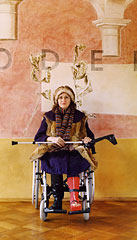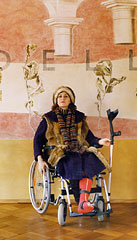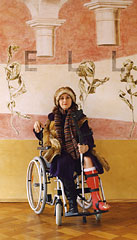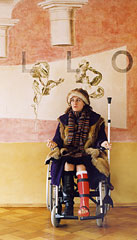2006





"No matter how he configures the ritual, the artist operates under individuation's compulsion to repeat: as a substitute for everyone else, he must again and again stir up and agitate the painful echoes located in the scars left behind by labor on the ego." (Beat Wyss, der Wille zur Kunst)
"Seated model" deals with one specific model of the image of the artist: an archetype, whose roots lie deep within the biographies of artists of the modern era, and which has constituted a kind of matrix for the modes of existence chosen by many producers of art within the sphere of occidental culture in recent centuries. It is a question of the model of the broken, suffering artistic personality, which positions itself autocratically at the centerpoint of the artist's conception of the world - a model that, meanwhile, has in many cases come to be regarded as outmoded. Within the artistic community, this model has ostensibly suffered from a loss of credibility. Yet if we consider contemporary phenomena, it has clearly even become highly diffused throughout the images of many other professional occupations. Contemporary work practices in many fields - and in particular in areas that focus on creativity, research and development - demand of their practitioners expenditures of time and energy that involve self-exploitation and which frequently drive both body and spirit to the edge of exhaustion, while at the same time involving a heightened sensitivity of ones own purported importance and productive presence.
In its serial mode of presentation, its sober approach to recording and its strategy of scenarization, which is based on declension, the work formulates an exploratory and ironic distance to its thematic content. Notwithstanding, the staging is based upon a "true" incident. Hurrying between various appointments, all (of course) involving art projects, Alba D'Urbano broke her leg. Sitting in her wheelchair and considering the unfortunate conjunction of circumstances, she reflected in general terms on the ancient theme of the artist as a projective surface - a function fulfilled by the artist somewhere between self-determination and role-playing, and perhaps in spite of all irony and awareness of critical metalevels. In any event, "seated model" could be seen as posing a question which oscillates between appropriation, rejection and reinterpretation. Here, the artist herself becomes a model. In her representative and art-producing function, she sits with fractured sanctimony in her wheelchair as though on a throne, expectantly awaiting a tribute in the form of photography (the photographer Tina Bara).
As in the other works, the two artists reflect here on the connections between art production and bodily inscription, between performances practices and both medial images and medial art history. Emerging here explicitly as an artistic strategy is the deployment and appropriation of other works of art and "backgrounds" for their own artistic productions and statements. The background of "seated model" is a fresco executed in 1999 by the artist Martin Figura for Alba D'Urbano's apartment. The work is based on architectural drawings by Leon Battista Alberti, and it reflects upon the model function of natural elements in relation to architectonic "building blocks" while confronting the fragile, ephemeral, living material with the abstract, constructed ideal.
Presentation: 5 Lambda-prints, 150 x 100 cm, diasec



 pictures
pictures